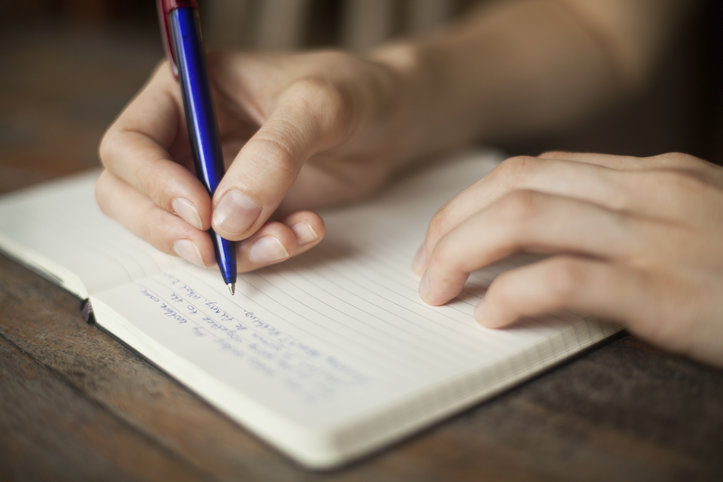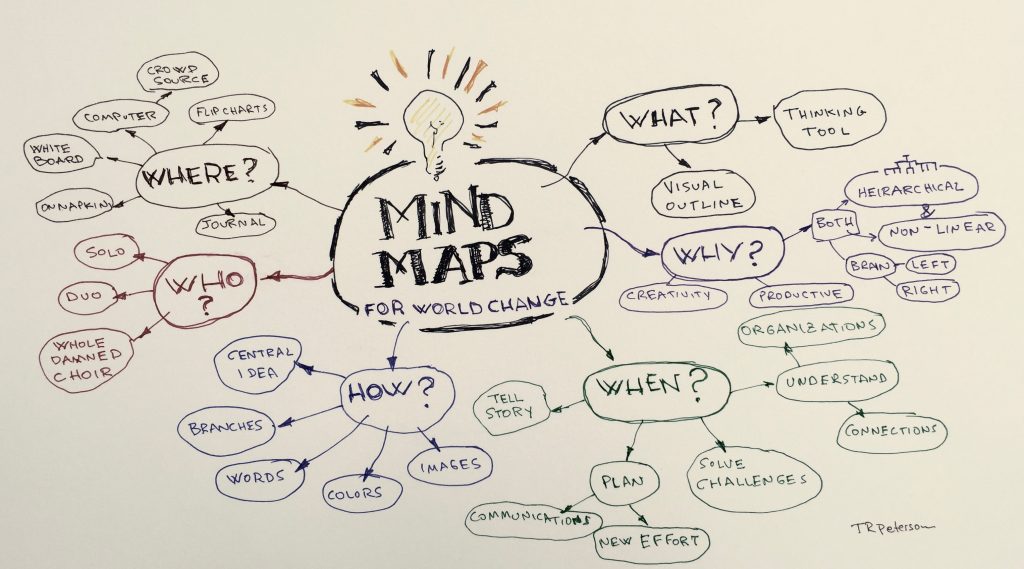In 2005, a man decided to study the mind and our potential to make the most out of our brainpower. Tony Buzan wrote “The mind map book: how to use radiant thinking to maximize your brain’s untapped potential” to prove that by using mind maps, people can access the most active parts of their brains to achieve what they want. The mind-mapping technique employs and engages a great range of cognitive skills to enhance our brain performance. Today, this technique is considered among the most effective ones to take notes and think of ideas either individually or within a group. Students can especially use mind maps for studying to maximize their retention and analytical skills.
Table of Contents
Mind maps for studying examples
Students and teachers all over the world have devised and created thousands of ways to use mind maps for different subjects and fields. Here are some inspirations for mind maps that students are actually using to study.
Creative mind map examples for students
These are some creative mind map ideas for students. Check them out if you need some inspiration to get you started.


How to make mind maps for studying?
The most important thing to start with is a paper in landscape form. This will give you extra space right and left to express your thoughts freely.
Then, add your main idea in the centre within a circle. For example, if you are writing an essay about the advantages and disadvantages of technology, write the word “technology” in the middle. Some people like to add an image instead; this all depends on your technique of learning. For visual learners, it is definitely recommended that you use an image. Why? It will make your brain more focused and will allow you to use your imagination more efficiently.
Some students like using colours in the form of highlighters or markers. You can do that if colours make studying interesting for you.
This next step is quite easy: you basically draw arrows that branch out of the main circle. Then, you keep adding secondary branches to the main ones (if needed). This diagram will simplify ideas for when you reread your mind map later. Think of the branches of a tree, they are diverse yet quite organized. Remember, it is all about CONNECTION!

It is also recommended that you only write down one or two words maximum within each branch; this makes it reader-friendly and simplifies studying later on. It will encourage your brain to make connections efficiently and quickly.
You can extend this “image” idea even further. You do not have to restrict yourself to only one image; why not add up to 10 or 15? The more, the merrier.
How to use mind maps for studying?
Phase #1 Remember your goal
Just like any action or decision you take in life, you have to adjust your mind to your ultimate goal before trying something new. This is what will motivate you when you find yourself uninspired during the process itself.
Perhaps your goal is to pass an exam, to get an A, or even to just challenge yourself! Just remember your goal while you’re studying! Write down your goals somewhere you can always look at while studying.
Phase #2 Acknowledge the importance of organization
It might seem cliche when people say that “For every minute spent organizing, an hour is earned.” But the truth is, organization makes an immense difference in the way your studying plan works. You need to be able to organize your thoughts before you get into anything new.
Avoid over-organizing! When students get into a motivated mood, they tend to create elaborate, detailed plans or schedules that they eventually fail to meet the next day. Just keeping your tasks organized is a great start; there is no need for you to go above and beyond when making a schedule. Keep your schedules as logical, realistic and convenient as possible.
Phase #3 Outline your limits
In order to ensure that you have tackled all that will be needed, you need to outline your limits when studying. It is quite easy to get carried away and go overboard; we don’t want that. Make sure to keep a list of the syllabus topics in front of you when studying.
This will consistently help you stay on track and also make sure that you cover everything. Remember that being overwhelmed when you’re studying serves the opposite purpose that we’re actually trying to achieve.
Phase #4 Collect, research, repeat
When studying, you will discover hundreds of resources, including books, articles, lectures, videos, and past exam papers. You ought to have a strategy in place for keeping everything organized and locating them as you need. Any system will work, just make sure to have one.
But the most valuable resource you have is TIME. Even if you can always leave everything to the last minute, is this always a risk you’re willing to take? An unforeseen emergency might interrupt your plans to do this strategy the week before an exam or even a few days before. Every student’s worst nightmare, right?
If you plan on changing the way you think about studying, this strategy is the first thing you should toss out. Exerting the studying effort over 2 weeks will definitely serve you much more than exerting the same effort in a few days.
Phase #5 Review your previous knowledge
Every piece of information that you know from previous studying will surely serve you in your future studies. So, don’t think that your previous information is useless. In fact, effective learning is always about the construction on top of old ideas. Think of bricks, for example!
Make a list of the basics you already know about the topic that can be useful for your following study. Mind maps are a great technique to learn this and facilitate the construction of new information onto old information.
This might interest you: 15 Free Educational Apps for Students
Phase #6 Embrace note-taking
Note-taking is a skill that, surprisingly, not many people are capable of. It can be necessary when you’re in a lecture, lesson, watching a video or even a recorded session. You need to be able to master the skill of note-taking if you want to better the quality of your studying. One common mistake that most students tend to make is that they borrow their friends’ notes. While this can be useful if you missed a lecture for example, it is not really that helpful if you want to absorb the material.

Writing notes in class using YOUR own words will definitely be more fruitful in the long run. You’ll find yourself able to comprehend more and think about what you’re writing, rather than just reading and rereading another person’s words.
Another essential tip is to find the medium that best works for you. Some people think that taking notes by hand is more effective than using the laptop, while others prefer typing over writing. Do not listen to other people’s preferences and follow their paths; instead, do what’s convenient and comfortable for you.
Phase #7 Start constructing your knowledge
Up until this point, everything we discussed has been focused on organising and acquiring data. But linking new concepts to earlier knowledge is essential to learning because it facilitates comprehension and memory.
Visualization is essential in this stage; a detailed and focused diagram is an excellent way to access the model you create when you read a text, analyse it, and then attempt to visualize it. As discussed earlier, just as note-taking works best when you do it yourself; the same goes for mind maps.
At this stage, focus on collecting all the data you need and spread it out on your map. This stage is the core of the process, you need to invest your time and energy here.
Phase #8 Revise everything
As Raymond Chandler, the American-British novelist once said: “Throw up into your typewriter every morning. Clean up every noon.”
See? Even writers never settle with their very first draft. What makes good writing great, is the ability to revise, refine and improve. Revision is the final step yet it’s a quite crucial step that every student should take after they are finished studying.
Revision helps you:
1- Evaluate your knowledge
2- Build on what you already know
3- Absorb ideas and concepts more effectively
4- Relate ideas together
5- Recall what you previously studied actively
6- Lessen the fear and anxiety caused by exams
7- Boost your confidence before an exam, which, in turn, will make you score better
7- Understand your weak points and identify them easily
8- Become much more organized
9- Understand your learning habits and behaviour better
Other articles: 8 Benefits of Virtual Education You Never Knew Before
Why use mind maps for studying?
Nerino J. Petro Jr. wrote an article about mind mapping in 2010; according to them, “consistent use of mind maps has been shown to improve note-taking skills and abilities, improve creativity in the thinking process, and improve learning and retention – by 10 percent or more – when properly used.”
Another article by Astrid Brinkmann in 2003 concluded that mind maps used in mathematics classrooms “enable people to visualize relationships between mathematical objects in a structured way that corresponds to the structure in mathematics.”
He believes that these mind maps are great for mathematics specifically because they employ both sides of the brain as they can work together to help in mathematical thinking.

Are mind maps good for studying?
Mind mapping could be an excellent method for you to take into consideration if you want to enhance your levels of retention and focus, as well as your organisational skills. Take a look at the reasons why experts think mind maps are good for studying:
- Assisting you with the memorization of terms, concepts, formulas and the relationship between topics you study
- Helping you make effective and fruitful revisions after you finish studying to consolidate information
- Enhancing your organization and note-taking skills both in class and at home
- Aiding with the construction of new ideas on top of old ones
- Visualizing your understanding of complex subjects or concepts in a neat, appealing and refined diagram
- Enabling you to form connections between the topic you’re studying at hand and the practical, real world
After all, remember that making studying fun will definitely make a huge difference in your attitude about it. Learning and studying should never be boring, tedious or difficult. By using mind maps to study, you are not only using your brain’s full potential, but you’re also enjoying the process itself. Find out what works for YOU to really reach your desired goals quickly and efficiently.
 Skolera LMS Blog Educational Technology Articles and News
Skolera LMS Blog Educational Technology Articles and News
